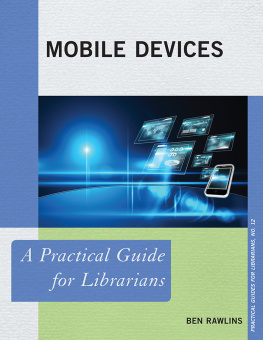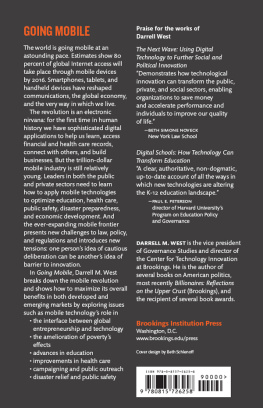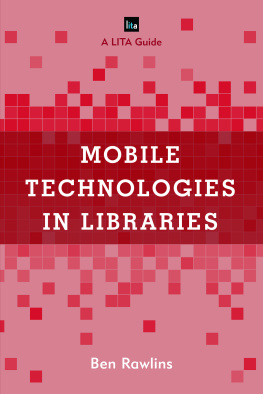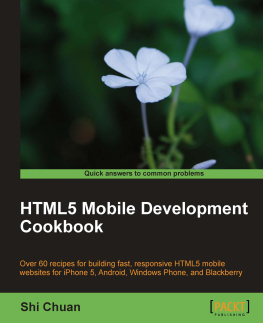MOBILE INTERFACES IN PUBLIC SPACES
With todays mobile devices, not only can we connect to the Internet anywhere at any time, we can also map our precise geographic coordinates and access location-specific information that enables us to engage with our surroundings in new ways. The proliferation of location-aware mobile technologies calls for a new understanding of how we define public spaces, how we deal with locational privacy, and how networks of power are developed today.
In Mobile Interfaces in Public Spaces, Adriana de Souza e Silva and Jordan Frith examine these spatial and social changes by framing the development of location-aware devices within the context of other mobile and portable technologies. These technologies work as interfaces to public spacesthat is, as symbolic systems that not only filter information but also reshape communication relationships and the environments in which social interaction takes place. de Souza e Silva and Frith suggest that far from alienating us from our surroundings, mobile interfaces can foster deeper connections with the people and places around us.
Adriana de Souza e Silva is Associate Professor in the Department of Communication at North Carolina State University. Her research focuses on how mobile and locative interfaces shape interactions with public spaces and create new forms of sociability. She is the co-editor of Digital Cityscapes: Merging Digital and Urban Playspaces, and co-author of Net-Locality: Why Location Matters in a Networked World.
Jordan Frith is a doctoral candidate in North Carolina State Universitys Communication, Rhetoric and Digital Media program. His main research interests are locative media and space, particularly how locative media may influence interactions in urban spaces. He has recently been published in the journals Mobilities and Communication, Culture, and Critique.
MOBILE INTERFACES IN PUBLIC SPACES
Locational Privacy, Control, and Urban Sociability
Adriana de Souza e Silva
and
Jordan Frith
First published 2012
by Routledge
711 Third Avenue, New York, NY 10017
Simultaneously published in the UK
by Routledge
2 Park Square, Milton Park, Abingdon, Oxon OX14 4RN
Routledge is an imprint of the Taylor & Francis Group, an informa business
2012 Taylor & Francis
The right of Adriana de Souza e Silva and Jordan Frith to be identified as authors of this work has been asserted by them in accordance with sections 77 and 78 of the Copyright, Designs and Patents Act 1988.
All rights reserved. No part of this book may be reprinted or reproduced or utilized in any form or by any electronic, mechanical, or other means, now known or hereafter invented, including photocopying and recording, or in any information storage or retrieval system, without permission in writing from the publishers.
Trademark notice: Product or corporate names may be trademarks or registered trademarks, and are used only for identification and explanation without intent to infringe.
Library of Congress Cataloging in Publication Data
Silva, Adriana de Souza e.
Mobile interfaces in public spaces: locational privacy, control, and urban sociability/by Adriana de Souza e Silva & Jordan Frith.
p. cm.
Includes bibliographical references and index.
1. Mobile computing. 2. Location-based servicesSocial aspects.
3. Social media. 4. Privacy, Right of. I. Frith, Jordan. II. Title. QA76.59.S55 2012
004dc23
2011038996
ISBN: 978-0-415-88823-3 (hbk)
ISBN: 978-0-415-50600-7 (pbk)
ISBN: 978-0-203-12396-6 (ebk)
To my mom, Elizabeth, with love.
Adriana
To my family and friends. I wouldnt be here without you.
Jordan
CONTENTS
FIGURES
Acknowledgments
The acknowledgements page is generally one of the hardest parts of a book to write. Its not that it is hard to thank others, but we always fear that we will forget someone who has offered help and has contributed to the realization of this project. We are very glad to have had so much support during the process of writing this book. First of all, we would like to thank our home institutions, North Carolina State University and the IT University of Copenhagen.
We both would like to thank Amani Naseem for her laborious help in getting permission for the images in this book. She has always been very reliable and competent, and we are immensely grateful for that.
A special thanks for Erica Wetter and Felisa Salvago-Keyes at Routledge, who worked with us since the beginning of this project, patiently answering our many questions, and promptly supporting its development so that this book could reach its full potential. Also thanks to our reviewers, who greatly helped us improve the manuscript.
We also would like to acknowledge the feedback we received during conferences where we presented chapters of this book along the way. Particularly, the National Communication Association conference in San Francisco (2010), the Homo Ludens 2.0 conference in Utrecht (2010), the Mobilities in Motion conference in Philadelphia (2011), and the Transforming Audiences 3 conference in London (2011).
Adriana
I particularly would like to thank the IT University of Copenhagen for having provided me with the perfect research environment when we were fiercely writing these chapters. Here I refer not only to the time provided for writing, but also the contact and conversations with scholars who inspired me and challenged some of my assumptions about technology. Particularly, I would like to thank Rich Ling, Irina Skhlovski, Gitte Stald, Lone Malmborg and John Paulin Hansen.
Jordan, thanks for working with me on this project, you have always been so much on top of our deadlines and provided me with valuable insights and great feedback. Thanks for making this one of the easiest and most pleasant scholarly collaborations Ive had.
Finally, I would like to thank my husband John for the ongoing support and immense love. He was never tired of engaging in conversations with me about location-based technologies and of repeatedly reading my text whenever I asked for it.
Jordan
I want to thank my colleagues at NC State, especially my cohort. I chose to come here because of all of you, and Ive never regretted it.
I want to thank Adriana for being as good a mentor as any doctoral student could possibly wish for. I wouldnt have had this opportunity if it wasnt for you, and youve been amazingly understanding throughout the entire process. At this stage in my career, I know Ive probably been spoiled by how easy it has been to work with you.
Also I want to thank my mother for putting up with my refusal to ever talk about my research. Hopefully, youll read this book and find out what Ive been up to for the last year.
Adriana and Jordan
September 2011
Introduction
In his book Speaking into the Air, John Durham Peters (1999) traces 2,000 years of thinking about communication, ranging from Socrates to Alan Turing. The story he tells is of philosophers forced to face one of the most glaring imperfections of the human condition: People cannot directly communicate with one another. Even if they grow up together, know each others history, and could trace each others life trajectory, the thoughts in ones head cannot transfer directly to somebody elses. The point seems obvious, but the imagining of a perfect form of communication is alive and well. We can perceive it whenever someone contrasts face-to-face communication with mediated communication. But what exactly is mediated communication anyway? Is there such a thing as unmediated communication? Even face-to-face communication is mediated by bodies, language, and a whole set of neural processes. As Peters points out, the reality of unmediated communication would be quite unpleasant. Philosophers may bemoan the impossibility of pure communication, but without the filters that make direct communication impossible, people would not be able to interact with each other.








